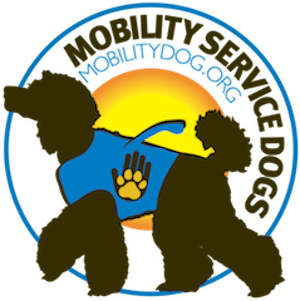Dogs Get the Point When Humans Point
MobilityDog Founder, Janie Heinrich, and her Service Dog
Dogs are clever communicators in how they convey information and how they receive it. Our pooches can:
Read our facial expressions.
Respond to our tone of voice.
Interpret body language; and
React to pointing gestures.
They exceed even chimpanzees, our closest animal kingdom relatives, in this last capacity.
Innate Behavior or Learned?
Service Dog Jake and his Puppy Raiser
Researchers have long debated whether dogs’ ability to interpret humans’ pointing is:
Innate (genetically programmed); or
Learned (acquired through training, observation, and socialization).
A recent study has taken a major step toward resolving the debate. We know that humans and dogs have lived together and cooperated for mutual benefit for tens of thousands of years. Have our canine companions repeatedly learned to interpret and respond to our pointing gestures, or can following a pointing cue become part of our dogs’ genetically influenced behavior? Research reveals it’s the second option, according to a recent study in Current Biology.
The Research – Finding Food and Watching Faces
Lido, a Mobility Service Dog Puppy
The researchers performed a series of tests on a population of 375 eight to ten-week-old puppies, assessing the degree to which human gazes, verbal direction and pointing influenced the dogs’ ability to solve a problem. Importantly, the puppies had spent little time being socialized with humans prior to the tests. Hence, any observed behavior could be expected to be largely innate rather than learned.
The research team discovered, for example, that the dogs were adept at following pointing gestures to identify the location of a food item hidden under a cup. When a researcher pointed at a cup or placed a yellow cube in front of the cup concealing the food item, the puppies found the food an average of 67 percent of the time. This is well above the 50 percent accuracy that would be expected if chance alone explained the results. Adult dogs perform at about the same level of accuracy, suggesting that experience over time does not improve the performance that puppies demonstrate.
In another test, an experimenter recited a 30-second script in a high-pitched voice resembling baby talk while looking at the dog. On average, the dogs gazed at the human’s face for about six seconds. Again, the gazing behavior showed an innate interest in human faces and voices.
The Results – Genetics Matter
Success at the food-finding task and the 30-second attention test were both highly heritable, the researchers concluded. They estimated that more than 40 percent of the variation in individual animals’ performance resulted from genetics. Human twin studies have yielded similar results, with estimates that about 47 percent of individual differences in cognitive measures is attributable to genetic factors. Among well-studied subjects like pigs and red squirrels, the heritability figures tend to be in the range of 20 to 30 percent. Regarding their canine subjects, the researchers said, “From early in development and prior to extensive socialization with humans, dogs exhibit a robust sensitivity to human gestural communication that does not rely on learning.”
One More Example of Evolution
Service Dog, Papi, Executing a Perfect Tuck Command
The heritability of behaviors like a pointing response provides one more example of how evolution has equipped dogs to thrive in cooperation with humans. As the researchers explained, “Through the process of domestication, dogs have evolved a biological preparedness for … human social interaction.”
One day, perhaps, our growing understanding of how canine genetics affect behavior will enable us to breed ever more successful service dogs. We know that as many as half the dogs that enter service dog training programs don’t graduate. As we gain insights into how genetics and learning interact to produce behavior, we may be able to increase our success in selecting service dog candidates and developing them to their full potential. Achieving this goal would, in turn, enable us to expedite training, save resources, and more efficiently provide service dogs to the humans who need them.
All Images Courtesy of MobilityDog.org.




